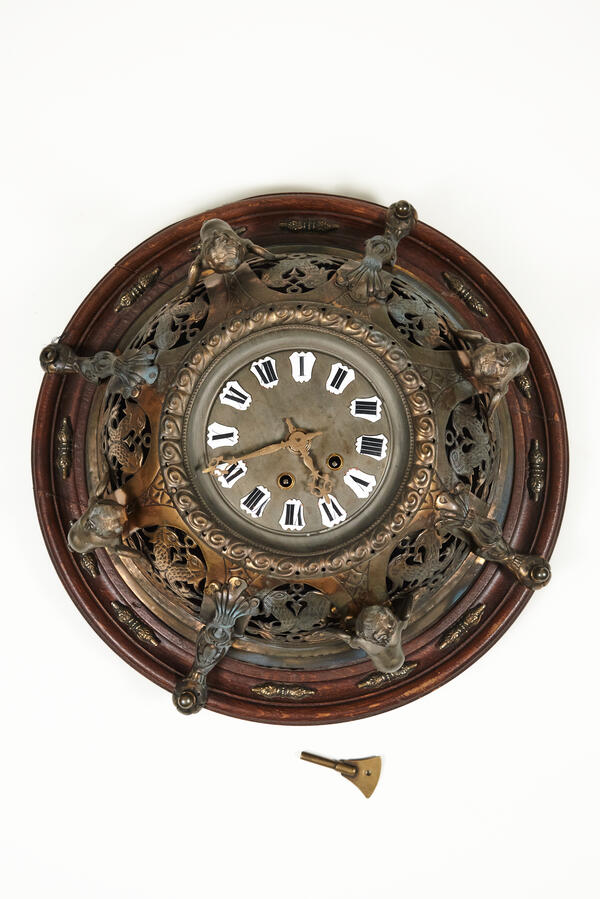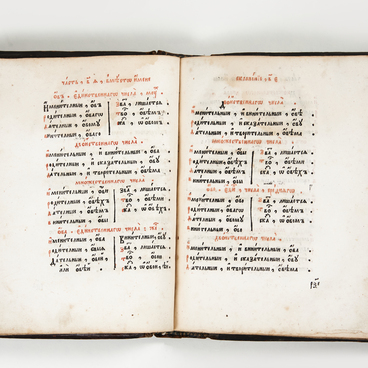The unusual shape of the clock from the museum collection attracts attention. The clock is large and massive, the case looks like a ship’s clock, but this clock is much bigger. The diameter of the round base is 50 cm. Of course, the name “marine” in this case is conditional; it only reflects the style of the clock design. The metal case of the clock is richly decorated. There are figures of seahorses carved on the metal surface, and on the sides, there are fantastic creatures — people with wings, bird and fish tails.
Specialists believe that the clock was customized and most likely, there is only a single copy. The time and place of production is also difficult to establish, since there is no mark on the mechanism that would tell us about the manufacturer. Presumably, the clock can be dated to the second half of the 19th century.
The history of the first wall clocks dates back to 16th-century England. The first private clocks were floor-mounted: they were so huge and it was difficult to place them in some other place, especially to hang on the wall. These products were made of expensive wood species. The case was decorated with bas-reliefs, carvings, and sculptures.
It is believed that the tower clock was the prototype of wall clocks. The first such clocks appeared in Europe in the 14th century. They were not equipped with faces and hands and did not show the time. Instead, the clock signaled the time by striking a bell. Most often they were used on monastery towers, where it was necessary to inform the monks that it was time to work or pray.
The appearance of lucerne wall-mounted clock in English workshops was the new stage in this story. There are two versions of the origin of this name. The first is that it was influenced by the shape of the clock case reminiscent of a candle lantern (the word “lucerna” is translated from Latin as “candle, lamp”). The second version is that it originated from the English word “lacten” or “brass”.
Wall clocks were brought to Russia during the reign of Peter I. Soon Russian artisans mastered the manufacturing process themselves. The most popular wall clocks were “pendelovki” (from the French word “pendelue” which means “pendulum”). “Pendelovki” were pendulum clocks produced in Austria in the late 18th and early 19th centuries.
Specialists believe that the clock was customized and most likely, there is only a single copy. The time and place of production is also difficult to establish, since there is no mark on the mechanism that would tell us about the manufacturer. Presumably, the clock can be dated to the second half of the 19th century.
The history of the first wall clocks dates back to 16th-century England. The first private clocks were floor-mounted: they were so huge and it was difficult to place them in some other place, especially to hang on the wall. These products were made of expensive wood species. The case was decorated with bas-reliefs, carvings, and sculptures.
It is believed that the tower clock was the prototype of wall clocks. The first such clocks appeared in Europe in the 14th century. They were not equipped with faces and hands and did not show the time. Instead, the clock signaled the time by striking a bell. Most often they were used on monastery towers, where it was necessary to inform the monks that it was time to work or pray.
The appearance of lucerne wall-mounted clock in English workshops was the new stage in this story. There are two versions of the origin of this name. The first is that it was influenced by the shape of the clock case reminiscent of a candle lantern (the word “lucerna” is translated from Latin as “candle, lamp”). The second version is that it originated from the English word “lacten” or “brass”.
Wall clocks were brought to Russia during the reign of Peter I. Soon Russian artisans mastered the manufacturing process themselves. The most popular wall clocks were “pendelovki” (from the French word “pendelue” which means “pendulum”). “Pendelovki” were pendulum clocks produced in Austria in the late 18th and early 19th centuries.



